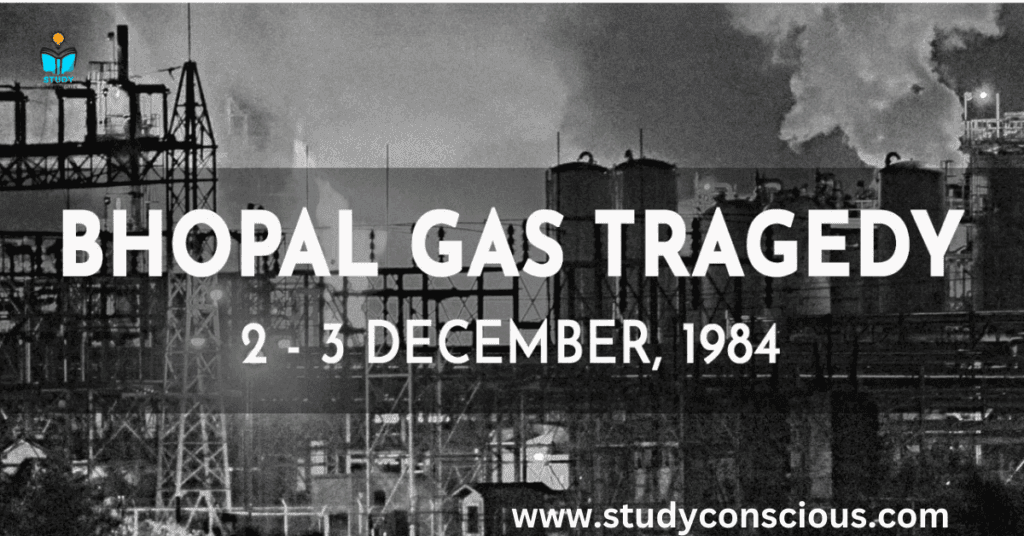National Pollution Control Day is observed annually in India on December 2. The day commemorates the lives lost in the tragic Bhopal Gas Tragedy of 1984, considered one of the worst industrial disasters in history. This day aims to raise awareness about pollution and its hazardous effects on human health and the environment while promoting steps to control and prevent pollution.
Significance
- Remembering the Bhopal Gas Tragedy: The day honors the victims of the disaster caused by the leak of methyl isocyanate gas from the Union Carbide plant in Bhopal, which claimed thousands of lives and caused severe health issues for many.
- Promoting Awareness: It highlights the importance of adhering to environmental laws and standards to ensure industrial safety and prevent such disasters.
- Encouraging Pollution Control Measures: The day emphasizes reducing air, water, and soil pollution through sustainable practices and technological innovations.
Objectives of National Pollution Control Day
- Raise Awareness: Educate individuals, communities, and industries about pollution’s harmful effects.
- Promote Cleaner Practices: Advocate for pollution control measures in industries, transportation, and daily life.
- Encourage Sustainable Living: Foster habits like recycling, waste management, and conservation of resources.
- Focus on Legislation: Highlight the importance of environmental laws and their enforcement to ensure public safety.
Pollution Control in India
India has established various regulations to tackle pollution, including:
- The Air (Prevention and Control of Pollution) Act, 1981.
- The Water (Prevention and Control of Pollution) Act, 1974.
- The Environment Protection Act, 1986.
- The National Green Tribunal (NGT), set up in 2010 for effective disposal of environmental cases.
Theme for 2024 (Expected)
While each year the themes may vary to emphasize different aspects of pollution control, they usually focus on:
- Transition to cleaner technologies.
- Adopting renewable energy sources.
- Public participation in pollution control efforts.
Bhopal Gas Tragedy
The Bhopal Gas Tragedy, which occurred on the night of December 2–3, 1984, in Bhopal, Madhya Pradesh, India, is one of the worst industrial disasters in history. It involved the accidental release of a highly toxic gas, methyl isocyanate (MIC), from the Union Carbide India Limited (UCIL) pesticide plant, resulting in the deaths of thousands of people and long-lasting health, environmental, and economic repercussions.

Key Facts about the Tragedy
- Date: Night of December 2–3, 1984.
- Location: Union Carbide India Limited (UCIL) pesticide plant, Bhopal, Madhya Pradesh, India.
- Toxic Gas: Methyl Isocyanate (MIC) – a highly volatile and deadly chemical used in pesticide manufacturing.
- Casualties:
- Immediate deaths: Over 3,000–5,000 people died within the first few days.
- Total deaths (long-term): Estimates range from 15,000–25,000 due to long-term health complications.
- Affected Population: Over 500,000 exposed to the gas, leading to chronic illnesses.
Sequence of Events
- Cause of the Leak:
- Water entered a tank containing 42 tons of methyl isocyanate (MIC) due to poor maintenance and safety practices.
- The reaction caused an exothermic reaction, leading to a massive increase in pressure inside the tank.
- The safety systems, including the refrigeration and scrubbers, were non-functional or turned off to cut costs.
- MIC gas escaped into the atmosphere.
- Spread of Gas:
- A dense cloud of toxic gas spread over nearby densely populated areas.
- Most of the affected people were slum dwellers living close to the factory.
- Immediate Impact:
- People exposed to the gas experienced severe symptoms like burning eyes, vomiting, breathlessness, and convulsions.
- Many died in their sleep, while others succumbed while trying to flee.
Health Impacts
- Acute Effects:
- Severe respiratory distress, pulmonary edema (fluid in the lungs), and organ failure.
- Eye irritation, blindness, and skin reactions.
- Long-Term Effects:
- Chronic respiratory diseases such as asthma and bronchitis.
- Neurological disorders, memory loss, and fatigue.
- Birth defects in children born to affected parents.
- Psychological trauma among survivors.
Environmental Consequences
- Soil Contamination:
- The factory site remains contaminated with toxic chemicals, including MIC residues and heavy metals.
- Groundwater near the site is still unsafe for consumption.
- Impact on Flora and Fauna:
- Local vegetation and wildlife suffered immediate and long-term damage due to the toxicity.
Aftermath
- Compensation and Legal Battles:
- Union Carbide Corporation (UCC), owned by Dow Chemical Company, faced lawsuits for negligence.
- In 1989, UCC agreed to pay $470 million as a settlement to the Indian government, far below the demanded amount.
- Survivors continue to fight for adequate compensation and rehabilitation.
- Government Response:
- Several relief camps were set up, but rehabilitation efforts were criticized for being insufficient.
- New environmental laws, such as the Environment Protection Act, 1986, were introduced.
- Criminal Case:
- In 2010, seven former UCIL employees were convicted of “criminal negligence” but were sentenced to only two years in prison, which led to public outrage.
Legacy of the Tragedy

- Corporate Accountability:
- Highlighted the dangers of poor safety standards and cost-cutting measures in industries.
- Became a global case study for corporate negligence.
- Stronger Environmental Regulations:
- Triggered stricter pollution and safety laws in India and around the world.
- Formation of the National Green Tribunal (NGT) in 2010 to address environmental issues.
- Unfinished Justice:
- Survivors and activists continue to demand:
- Adequate compensation.
- Complete cleanup of the factory site.
- Accountability of Dow Chemicals, which took over Union Carbide.
- Survivors and activists continue to demand:
Memorials
- Bhopal Gas Memorial: Built to honor the victims.
- Various organizations, including the Bhopal Gas Peedit Mahila Udyog Sangathan (BGPMUS), continue to fight for justice and support survivors.
Lessons Learned
- Industrial Safety:
- Importance of rigorous safety protocols and regular maintenance of industrial facilities.
- Emergency Preparedness:
- Need for effective disaster response plans and community awareness.
- Environmental Protection:
- Long-term effects of toxic substances necessitate stricter environmental regulations.
The Bhopal Gas Tragedy remains a sobering reminder of the devastating impact of industrial negligence and inadequate safety measures, urging the global community to prioritize human life and environmental safety over corporate profits.











